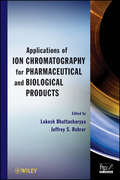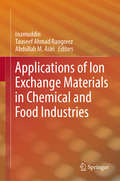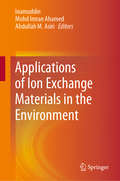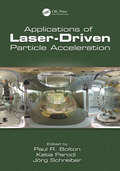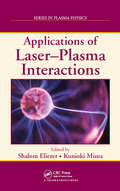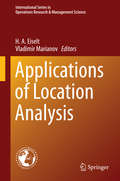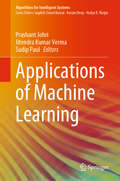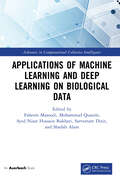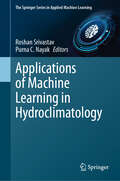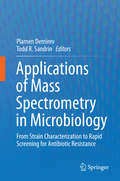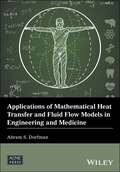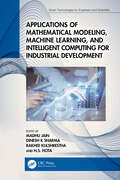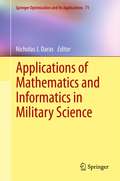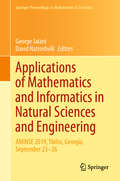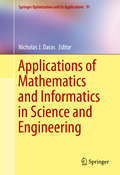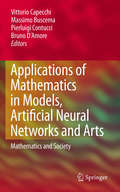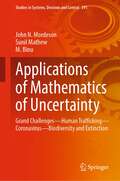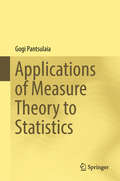- Table View
- List View
Applications of Ion Chromatography in the Analysis of Pharmaceutical and Biological Products
by Lokesh Bhattacharyya Jeffrey S. RohrerThis is a comprehensive source of information on the application of ion chromatography (IC) in the analysis of pharmaceutical drugs and biologicals. This book, with contributors from academia, pharma, the biotech industry, and instrument manufacturing, presents the different perspectives, experience, and expertise of the thought leaders of IC in a comprehensive manner. It explores potential IC applications in different aspects of product development and quality control testing. In addition, an appendix section gives information on critical physical and chromatographic parameters related to IC and information on current manufacturers of IC systems, columns, and other components.
Applications of Ion Exchange Materials in Biomedical Industries
by InamuddinThis book presents the applications of ion-exchange materials in the biomedical industries. It includes topics related to the application of ion exchange chromatography in determination, extraction and separation of various compounds such as amino acids, morphine, antibiotics, nucleotides, penicillin and many more. This title is a highly valuable source of knowledge on ion-exchange materials and their applications suitable for postgraduate students and researchers but also to industrial R&D specialists in chemistry, chemical, and biochemical technology. Additionally, this book will provide an in-depth knowledge of ion-exchange column and operations suitable for engineers and industrialists.
Applications of Ion Exchange Materials in Chemical and Food Industries
by Inamuddin Tauseef Ahmad Rangreez Abdullah M. AsiriThis book presents the applications of ion-exchange materials in the chemical and food industries. It includes topics related to the application of ion exchange chromatography in water softening, purification and separation of chemicals, separation and purification of food products and catalysis. This title is a highly valuable source of knowledge on ion-exchange materials and their applications suitable for postgraduate students and researchers but also to industrial R&D specialists in chemistry, chemical, and biochemical technology. Additionally, this book will provide an in-depth knowledge of ion-exchange column and operations suitable for engineers and industrialists.
Applications of Ion Exchange Materials in the Environment
by Inamuddin Mohd Imran Ahamed Abdullah M. AsiriThis book presents the applications of ion-exchange materials in the area of environmental analysis and treatment. It includes chapters on applications of organic, inorganic and composite ion exchange materials and hexacyanoferrates in various fields such as chemical and biochemical separations, water purification, removal of harmful impurities, dyes and cationic and anionic complexes. This title is a highly valuable source of knowledge on ion-exchange materials and their applications suitable for postgraduate students and researchers but also to industrial R&D specialists in chemistry, chemical, and biochemical technology. Additionally, this book will provide an in-depth knowledge of ion-exchange column and operations suitable for engineers and industrialists.
Applications of Ionic Liquids in Polymer Science and Technology
by David MecerreyesThis book summarizes the latest knowledge in the science and technology of ionic liquids and polymers in different areas. Ionic liquids (IL) are actively being investigated in polymer science and technology for a number of different applications. In the first part of the book the authors present the particular properties of ionic liquids as speciality solvents. The state-of-the art in the use of ionic liquids in polymer synthesis and modification reactions including polymer recycling is outlined. The second part focuses on the use of ionic liquids as speciality additives such as plasticizers or antistatic agents. The third part examines the use of ionic liquids in the design of functional polymers (usually called polymeric ionic liquids (PIL) or poly(ionic liquids)). Many important applications in diverse scientific and industrial areas rely on these polymers, like polymer electrolytes in electrochemical devices, building blocks in materials science, nanocomposites, gas membranes, innovative anion sensitive materials, smart surfaces, and a countless set range of emerging applications in different fields such as energy, optoelectronics, analytical chemistry, biotechnology, nanomedicine or catalysis.
Applications of Item Response Theory To Practical Testing Problems
by F. M. LordPublished in 1980, Applications of Item Response Theory To Practical Testing Problems is a valuable contribution to the field of Education.
Applications of Laser-Driven Particle Acceleration
by Paul Bolton Katia Parodi Jörg SchreiberThe first book of its kind to highlight the unique capabilities of laser-driven acceleration and its diverse potential, Applications of Laser-Driven Particle Acceleration presents the basic understanding of acceleration concepts and envisioned prospects for selected applications. As the main focus, this new book explores exciting and diverse application possibilities, with emphasis on those uniquely enabled by the laser driver that can also be meaningful and realistic for potential users. It also emphasises distinction, in the accelerator context, between laser-driven accelerated particle sources and the integrated laser-driven particle accelerator system (all-optical and hybrid versions). A key aim of the book is to inform multiple, interdisciplinary research communities of the new possibilities available and to inspire them to engage with laser-driven acceleration, further motivating and advancing this developing field. Material is presented in a thorough yet accessible manner, making it a valuable reference text for general scientific and engineering researchers who are not necessarily subject matter experts. Applications of Laser-Driven Particle Acceleration is edited by Professors Paul R. Bolton, Katia Parodi, and Jörg Schreiber from the Department of Medical Physics at the Ludwig-Maximilians-Universität München in München, Germany. Features: Reviews the current understanding and state-of-the-art capabilities of laser-driven particle acceleration and associated energetic photon and neutron generation Presents the intrinsically unique features of laser-driven acceleration and particle bunch yields Edited by internationally renowned researchers, with chapter contributions from global experts
Applications of Laser-Plasma Interactions
by Shalom Eliezer Kunioki MimaRecent advances in the development of lasers with more energy, power, and brightness have opened up new possibilities for exciting applications. Applications of Laser-Plasma Interactions reviews the current status of high power laser applications. The book first explores the science and technology behind the ignition and burn of imploded fusion fue
Applications of Lie Groups to Difference Equations (Differential and Integral Equations and Their Applications)
by Vladimir DorodnitsynIntended for researchers, numerical analysts, and graduate students in various fields of applied mathematics, physics, mechanics, and engineering sciences, Applications of Lie Groups to Difference Equations is the first book to provide a systematic construction of invariant difference schemes for nonlinear differential equations. A guide to methods
Applications of Location Analysis (International Series in Operations Research & Management Science #232)
by H. A. Eiselt Vladimir MarianovThis book, companion to Foundations of Location Analysis (Springer, 2011), highlights some of the applications of location analysis within the spheres of businesses, those that deal with public services and applications that deal with law enforcement and first responders. While the Foundations book reviewed the theory and first contributions, this book describes how different location techniques have been used to solve real problems. Since many real problems comprise multiple objectives, in this book there is more presence of tools from multicriteria decision making and multiple-objective optimization. The section on business applications looks at such problems as locating bank branches, the potential location of a logistics park, sustainable forest management and layout problems in a hospital, a much more difficult type of problem than mere location problems. The section on public services presents chapters on the design of habitats for wildlife, control of forest fires, the location of intelligent sensors along highways for timely emergency response, locating breast cancer screening centers, an economic analysis for the locations of post offices and school location. The final section of the book includes chapters on the well-known problem of locating fire stations, a model for the location of sensors for travel time information, the problem of police districting, locations of jails, location of Coast Guard vessels and finally, a survey of military applications of location analysis throughout different periods of recent history.
Applications of Machine intelligence in Engineering: Proceedings of 2nd Global Conference on Artificial Intelligence and Applications (GCAIA, 2021), September 8-10, 2021, Jaipur, India
by Jyotsna Kumar MandalThe Global Conference on Artificial Intelligence and Applications (GCAIA 2021) provides a prominent venue for researchers, engineers, entrepreneurs, and scholar students to share their research ideas in the area of AI. Academic researchers would reveal the results and conclusions of laboratory based investigations via the GCAIA 21 platform, which bridges the gap between academia, industry, and government ethics. The GCAIA 21 platform will also bring together regional and worldwide issues to explore current advancements in contemporary Computation Intelligence. This Conference Proceedings volume contains the written versions of most of the contributions presented during the conference of GCAIA 2021. The conference has provided an excellent chance for researchers from diverse locations to present and debate their work in the field of artificial intelligence and its applications. It includes a selection of 62 papers. All accepted papers were subjected to strict peer-review by 2–4 expert referees. The papers have been selected for this volume because of their quality and their relevance to the theme of the conference.
Applications of Machine Learning (Algorithms for Intelligent Systems)
by Prashant Johri Jitendra Kumar Verma Sudip PaulThis book covers applications of machine learning in artificial intelligence. The specific topics covered include human language, heterogeneous and streaming data, unmanned systems, neural information processing, marketing and the social sciences, bioinformatics and robotics, etc. It also provides a broad range of techniques that can be successfully applied and adopted in different areas. Accordingly, the book offers an interesting and insightful read for scholars in the areas of computer vision, speech recognition, healthcare, business, marketing, and bioinformatics.
Applications of Machine Learning and Deep Learning on Biological Data (Advances in Computational Collective Intelligence)
by Faheem Masoodi Mohammad Quasim Bukhari, Syed Nisar Hussain Sarvottam Dixit Shadab AlamThe automated learning of machines characterizes machine learning (ML). It focuses on making data-driven predictions using programmed algorithms. ML has several applications, including bioinformatics, which is a discipline of study and practice that deals with applying computational derivations to obtain biological data. It involves the collection, retrieval, storage, manipulation, and modeling of data for analysis or prediction made using customized software. Previously, comprehensive programming of bioinformatical algorithms was an extremely laborious task for such applications as predicting protein structures. Now, algorithms using ML and deep learning (DL) have increased the speed and efficacy of programming such algorithms. Applications of Machine Learning and Deep Learning on Biological Data is an examination of applying ML and DL to such areas as proteomics, genomics, microarrays, text mining, and systems biology. The key objective is to cover ML applications to biological science problems, focusing on problems related to bioinformatics. The book looks at cutting-edge research topics and methodologies in ML applied to the rapidly advancing discipline of bioinformatics. ML and DL applied to biological and neuroimaging data can open new frontiers for biomedical engineering, such as refining the understanding of complex diseases, including cancer and neurodegenerative and psychiatric disorders. Advances in this field could eventually lead to the development of precision medicine and automated diagnostic tools capable of tailoring medical treatments to individual lifestyles, variability, and the environment. Highlights include: Artificial Intelligence in treating and diagnosing schizophrenia An analysis of ML’s and DL’s financial effect on healthcare An XGBoost-based classification method for breast cancer classification Using ML to predict squamous diseases ML and DL applications in genomics and proteomics Applying ML and DL to biological data
Applications of Machine Learning in Big-Data Analytics and Cloud Computing
by Subhendu Kumar Pani Somanath Tripathy George Jandieri Sumit Kundu Talal Ashraf ButtCloud Computing and Big Data technologies have become the new descriptors of the digital age. The global amount of digital data has increased more than nine times in volume in just five years and by 2030 its volume may reach a staggering 65 trillion gigabytes. This explosion of data has led to opportunities and transformation in various areas such as healthcare, enterprises, industrial manufacturing and transportation. New Cloud Computing and Big Data tools endow researchers and analysts with novel techniques and opportunities to collect, manage and analyze the vast quantities of data. In Cloud and Big Data Analytics, the two areas of Swarm Intelligence and Deep Learning are a developing type of Machine Learning techniques that show enormous potential for solving complex business problems. Deep Learning enables computers to analyze large quantities of unstructured and binary data and to deduce relationships without requiring specific models or programming instructions.This book introduces the state-of-the-art trends and advances in the use of Machine Learning in Cloud and Big Data Analytics. The book will serve as a reference for Data Scientists, systems architects, developers, new researchers and graduate level students in Computer and Data science. The book will describe the concepts necessary to understand current Machine Learning issues, challenges and possible solutions as well as upcoming trends in Big Data Analytics.
Applications of Machine Learning in Hydroclimatology (The Springer Series in Applied Machine Learning)
by Roshan Srivastav Purna C. NayakApplications of Machine Learning in Hydroclimatology is a comprehensive exploration of the transformative potential of machine learning for addressing critical challenges in water resources management. The book explores how artificial intelligence can unravel the complexities of hydrological systems, providing researchers and practitioners with cutting-edge tools to model, predict, and manage these systems with greater precision and effectiveness. It thoroughly examines the modeling of hydrometeorological extremes, such as floods and droughts, which are becoming increasingly difficult to predict due to climate change. By leveraging AI-driven methods to forecast these extremes, the book offers innovative approaches that enhance predictive accuracy. It emphasizes the importance of analyzing non-stationarity and uncertainty in a rapidly evolving climate landscape, illustrating how statistical and frequency analyses can improve hydrological forecasts. Moreover, the book explores the impact of climate change on flood risks, drought occurrences, and reservoir operations, providing insights into how these phenomena affect water resource management. To provide practical solutions, the book includes case studies that showcase effective mitigation measures for water-related challenges. These examples highlight the use of machine learning techniques such as deep learning, reinforcement learning, and statistical downscaling in real-world scenarios. They demonstrate how artificial intelligence can optimize decision-making and resource management while improving our understanding of complex hydrological phenomena. By utilizing machine learning architectures tailored to hydrology, the book presents physics-guided models, data-driven techniques, and hybrid approaches that can be used to address water management issues. Ultimately, Applications of Machine Learning in Hydroclimatology empowers researchers, practitioners, and policymakers to harness machine learning for sustainable water management. It bridges the gap between advanced AI technologies and hydrological science, offering innovative solutions to tackle today's most pressing challenges in water resources.
Applications of MALDI-TOF Spectroscopy (Topics in Current Chemistry #331)
by Zongwei Cai Shuying LiuMALDI-ToF Mass Spectrometry for Studying Noncovalent Complexes of Biomolecules, by Stefanie Mädler, Elisabetta Boeri Erba, Renato Zenobi Application of MALDI-TOF-Mass Spectrometry to Proteome Analysis Using Stain-Free Gel Electrophoresis, by Iuliana Susnea, Bogdan Bernevic, Michael Wicke, Li Ma, Shuying Liu, Karl Schellander, Michael Przybylski MALDI Mass Spectrometry for Nucleic Acid Analysis, by Xiang Gao, Boon-Huan Tan, Richard J. Sugrue, Kai Tang Determination of Peptide and Protein Disulfide Linkages by MALDI Mass Spectrometry, by Hongmei Yang, Ning Liu, Shuying Liu MALDI In-Source Decay, from Sequencing to Imaging, by Delphine Debois, Nicolas Smargiasso, Kevin Demeure, Daiki Asakawa, Tyler A. Zimmerman, Loïc Quinton, Edwin De Pauw Advances of MALDI-TOF MS in the Analysis of Traditional Chinese Medicines, by Minghua Lu, Zongwei Cai Chemical and Biochemical Applications of MALDI TOF-MS Based on Analyzing the Small Organic Compounds, by Haoyang Wang, Zhixiong Zhao, Yinlong Guo Bioinformatic Analysis of Data Generated from MALDI Mass Spectrometry for Biomarker Discovery, by Zengyou He, Robert Z. Qi, Weichuan Yu
Applications of Mass Spectrometry in Microbiology: From Strain Characterization to Rapid Screening for Antibiotic Resistance
by Plamen Demirev Todd R. SandrinIn the last quarter century, advances in mass spectrometry (MS) have been at the forefront of efforts to map complex biological systems including the human metabolome, proteome, and microbiome. All of these developments have allowed MS to become a well-established molecular level technology for microorganism characterization. MS has demonstrated its considerable advantage as a rapid, accurate, and cost-effective method for microorganism identification, compared to conventional phenotypic techniques. In the last several years, applications of MS for microorganism characterization in research, clinical microbiology, counter-bioterrorism, food safety, and environmental monitoring have been documented in thousands of publications. Regulatory bodies in Europe, the US, and elsewhere have approved MS-based assays for infectious disease diagnostics. As of mid-2015, more than 3300 commercial MS systems for microorganism identification have been deployed worldwide in hospitals and clinical labs. While previous work has covered broader approaches in using MS to characterize microorganisms at the species level or above, this book focuses on strain-level and subtyping applications. In twelve individual chapters, innovators, leaders and practitioners in the field from around the world have contributed to a comprehensive overview of current and next-generation approaches for MS-based microbial characterization at the subspecies and strain levels. Chapters include up-to-date reference lists as well as web-links to databases, recommended software, and other useful tools. The emergence of new, antibiotic-resistant strains of human or animal pathogens is of extraordinary concern not only to the scientific and medical communities, but to the general public as well. Developments of novel MS-based assays for rapid identification of strains of antibiotic-resistant microorganisms are reviewed in the book as well. Microbiologists, bioanalytical scientists, infectious disease specialists, clinical laboratory and public health practitioners as well as researchers in universities, hospitals, government labs, and the pharmaceutical and biotechnology industries will find this book to be a timely and valuable resource.
Applications of Mathematical Heat Transfer and Fluid Flow Models in Engineering and Medicine (Wiley-ASME Press Series)
by Abram S. DorfmanApplications of mathematical heat transfer and fluid flow models in engineering and medicine Abram S. Dorfman, University of Michigan, USA Engineering and medical applications of cutting-edge heat and flow models This book presents innovative efficient methods in fluid flow and heat transfer developed and widely used over the last fifty years. The analysis is focused on mathematical models which are an essential part of any research effort as they demonstrate the validity of the results obtained. The universality of mathematics allows consideration of engineering and biological problems from one point of view using similar models. In this book, the current situation of applications of modern mathematical models is outlined in three parts. Part I offers in depth coverage of the applications of contemporary conjugate heat transfer models in various industrial and technological processes, from aerospace and nuclear reactors to drying and food processing. In Part II the theory and application of two recently developed models in fluid flow are considered: the similar conjugate model for simulation of biological systems, including flows in human organs, and applications of the latest developments in turbulence simulation by direct solution of Navier-Stokes equations, including flows around aircraft. Part III proposes fundamentals of laminar and turbulent flows and applied mathematics methods. The discussion is complimented by 365 examples selected from a list of 448 cited papers, 239 exercises and 136 commentaries. Key features: Peristaltic flows in normal and pathologic human organs. Modeling flows around aircraft at high Reynolds numbers. Special mathematical exercises allow the reader to complete expressions derivation following directions from the text. Procedure for preliminary choice between conjugate and common simple methods for particular problem solutions. Criterions of conjugation, definition of semi-conjugate solutions. This book is an ideal reference for graduate and post-graduate students and engineers.
Applications of Mathematical Modeling, Machine Learning, and Intelligent Computing for Industrial Development (Smart Technologies for Engineers and Scientists)
by Madhu Jain Dinesh K. Sharma Rakhee Kulshrestha H. S. HotaThe text focuses on mathematical modeling and applications of advanced techniques of machine learning, and artificial intelligence, including artificial neural networks, evolutionary computing, data mining, and fuzzy systems to solve performance and design issues more precisely. Intelligent computing encompasses technologies, algorithms, and models in providing effective and efficient solutions to a wide range of problems, including the airport’s intelligent safety system. It will serve as an ideal reference text for senior undergraduate, graduate students, and academic researchers in fields that include industrial engineering, manufacturing engineering, computer engineering, and mathematics. The book- Discusses mathematical modeling for traffic, sustainable supply chain, vehicular Ad-Hoc networks, and internet of things networks with intelligent gateways. Covers advanced machine learning, artificial intelligence, fuzzy sys- tems, evolutionary computing, and data mining techniques for real- world problems. Presents applications of mathematical models in chronic diseases such as kidney and coronary artery diseases. Highlights advances in mathematical modeling, strength, and benefits of machine learning and artificial intelligence, including driving goals, applicability, algorithms, and processes involved. Showcases emerging real-life topics on mathematical models, machine learning, and intelligent computing using an interdisciplinary approach. The text presents emerging real-life topics on mathematical models, machine learning, and intelligent computing in a single volume. It will serve as an ideal text for senior undergraduate students, graduate students, and researchers in diverse fields, including industrial and manufacturing engineering, computer engineering, and mathematics.
Applications of Mathematics and Informatics in Military Science (Springer Optimization and Its Applications #71)
by Nicholas DarasAnalysis, assessment, and data management are core tools required for operation research analysts. The April 2011 conference held at the Helenic Military Academy addressed these issues with efforts to collect valuable recommendations for improving analysts' capabilities to assess and communicate the necessary qualitative data to military leaders. This unique volume is an outgrowth of the April conference and comprises of contributions from the fields of science, mathematics, and the military, bringing Greek research findings to the world. Topics cover a wide variety of mathematical methods used with application to defense and security. Each contribution considers directions and pursuits of scientists that pertain to the military as well as the theoretical background required for methods, algorithms, and techniques used in military applications. The direction of theoretical results in these applications is conveyed and open problems and future areas of focus are highlighted. A foreword will be composed by a member of N.A.T.O. or a ranking member of the armed forces. Topics covered include: applied OR and military applications, signal processing, scattering, scientific computing and applications, combat simulation and statistical modeling, satellite remote sensing, and applied informatics - cryptography and coding. The contents of this volume will be of interest to a diverse audience including military operations research analysts, the military community at large, and practitioners working with mathematical methods and applications to informatics and military science.
Applications of Mathematics and Informatics in Natural Sciences and Engineering: AMINSE 2019, Tbilisi, Georgia, September 23-26 (Springer Proceedings in Mathematics & Statistics #334)
by George Jaiani David NatroshviliThis book presents peer-reviewed papers from the 4th International Conference on Applications of Mathematics and Informatics in Natural Sciences and Engineering (AMINSE2019), held in Tbilisi, Georgia, in September 2019. Written by leading researchers from Austria, France, Germany, Georgia, Hungary, Romania, South Korea and the UK, the book discusses important aspects of mathematics, and informatics, and their applications in natural sciences and engineering. It particularly focuses on Lie algebras and applications, strategic graph rewriting, interactive modeling frameworks, rule-based frameworks, elastic composites, piezoelectrics, electromagnetic force models, limiting distribution, degenerate Ito-SDEs, induced operators, subgaussian random elements, transmission problems, pseudo-differential equations, and degenerate partial differential equations. Featuring theoretical, practical and numerical contributions, the book will appeal to scientists from various disciplines interested in applications of mathematics and informatics in natural sciences and engineering.
Applications of Mathematics and Informatics in Science and Engineering (Springer Optimization and Its Applications #91)
by Nicholas J. DarasAnalysis, assessment, and data management are core competencies for operation research analysts. This volume addresses a number of issues and developed methods for improving those skills. It is an outgrowth of a conference held in April 2013 at the Hellenic Military Academy and brings together a broad variety of mathematical methods and theories with several applications. It discusses directions and pursuits of scientists that pertain to engineering sciences. It is also presents the theoretical background required for algorithms and techniques applied to a large variety of concrete problems. A number of open questions as well as new future areas are also highlighted. This book will appeal to operations research analysts, engineers, community decision makers, academics, the military community, practitioners sharing the current "state-of-the-art," and analysts from coalition partners. Topics covered include Operations Research, Games and Control Theory, Computational Number Theory and Information Security, Scientific Computing and Applications, Statistical Modeling and Applications, Systems of Monitoring and Spatial Analysis.
Applications of Mathematics in Models, Artificial Neural Networks and Arts: Mathematics and Society
by Pierluigi Contucci Bruno D'Amore Massimo Buscema Vittorio CapecchiThe book shows a very original organization addressing in a non traditional way, but with a systematic approach, to who has an interest in using mathematics in the social sciences. The book is divided in four parts: (a) a historical part, written by Vittorio Capecchi which helps us understand the changes in the relationship between mathematics and sociology by analyzing the mathematical models of Paul F. Lazarsfeld, the model of simulation and artificial societies, models of artificial neural network and considering all the changes in scientific paradigms considered; (b) a part coordinated by Pier Luigi Contucci on mathematical models that consider the relationship between the mathematical models that come from physics and linguistics to arrive at the study of society and those which are born within sociology and economics; (c) a part coordinated by Massimo Buscema analyzing models of artificial neural networks; (d) a part coordinated by Bruno D'Amore which considers the relationship between mathematics and art. The title of the book "Mathematics and Society" was chosen because the mathematical applications exposed in the book allow you to address two major issues: (a) the general theme of technological innovation and quality of life (among the essays are on display mathematical applications to the problems of combating pollution and crime, applications to mathematical problems of immigration, mathematical applications to the problems of medical diagnosis, etc.) (b) the general theme of technical innovation and creativity, for example the art and mathematics section which connects to the theme of creative cities. The book is very original because it is not addressed only to those who are passionate about mathematical applications in social science but also to those who, in different societies, are: (a) involved in technological innovation to improve the quality of life; (b) involved in the wider distribution of technological innovation in different areas of creativity (as in the project "Creative Cities Network" of UNESCO).
Applications of Mathematics of Uncertainty: Grand Challenges—Human Trafficking—Coronavirus—Biodiversity and Extinction (Studies in Systems, Decision and Control #391)
by John N. Mordeson Sunil Mathew M. BinuThis book provides an examination of major problems facing the world using mathematics of uncertainty. These problems include climate change, coronavirus pandemic, human tracking, biodiversity, and other grand challenges. Mathematics of uncertainty is used in a modern more general sense than traditional mathematics. Since accurate data is impossible to obtain concerning human tracking and other global problems, mathematics of uncertainty is an ideal discipline to study these problems. The authors place several scientific studies into different mathematical settings such as nonstandard analysis and soft logic. Fuzzy differentiation is used to model the spread of diseases such as the coronavirus. The book uses fuzzy graph theory to examine the problems of human tracking and illegal immigration. The book is an excellent reference source for advanced under-graduate and graduate students in mathematics and the social sciences as well as for researchers and teachers.
Applications of Measure Theory to Statistics
by Gogi PantsulaiaThis book aims to put strong reasonable mathematical senses in notions of objectivity and subjectivity for consistent estimations in a Polish group by using the concept of Haar null sets in the corresponding group. This new approach - naturally dividing the class of all consistent estimates of an unknown parameter in a Polish group into disjoint classes of subjective and objective estimates - helps the reader to clarify some conjectures arising in the criticism of null hypothesis significance testing. The book also acquaints readers with the theory of infinite-dimensional Monte Carlo integration recently developed for estimation of the value of infinite-dimensional Riemann integrals over infinite-dimensional rectangles. The book is addressed both to graduate students and to researchers active in the fields of analysis, measure theory, and mathematical statistics.
